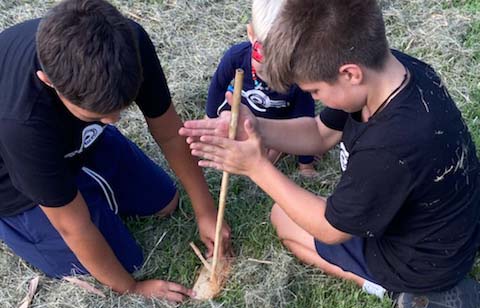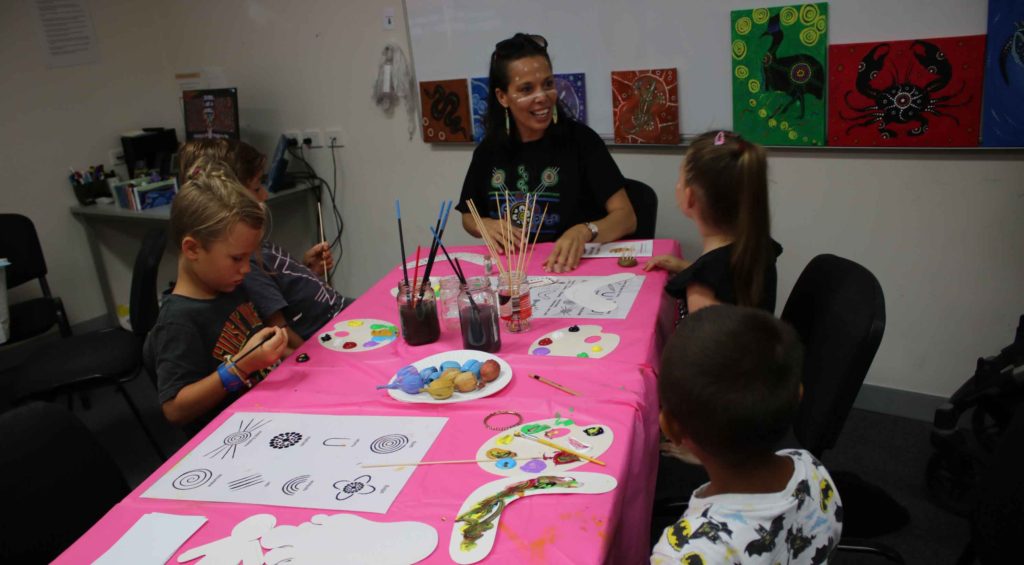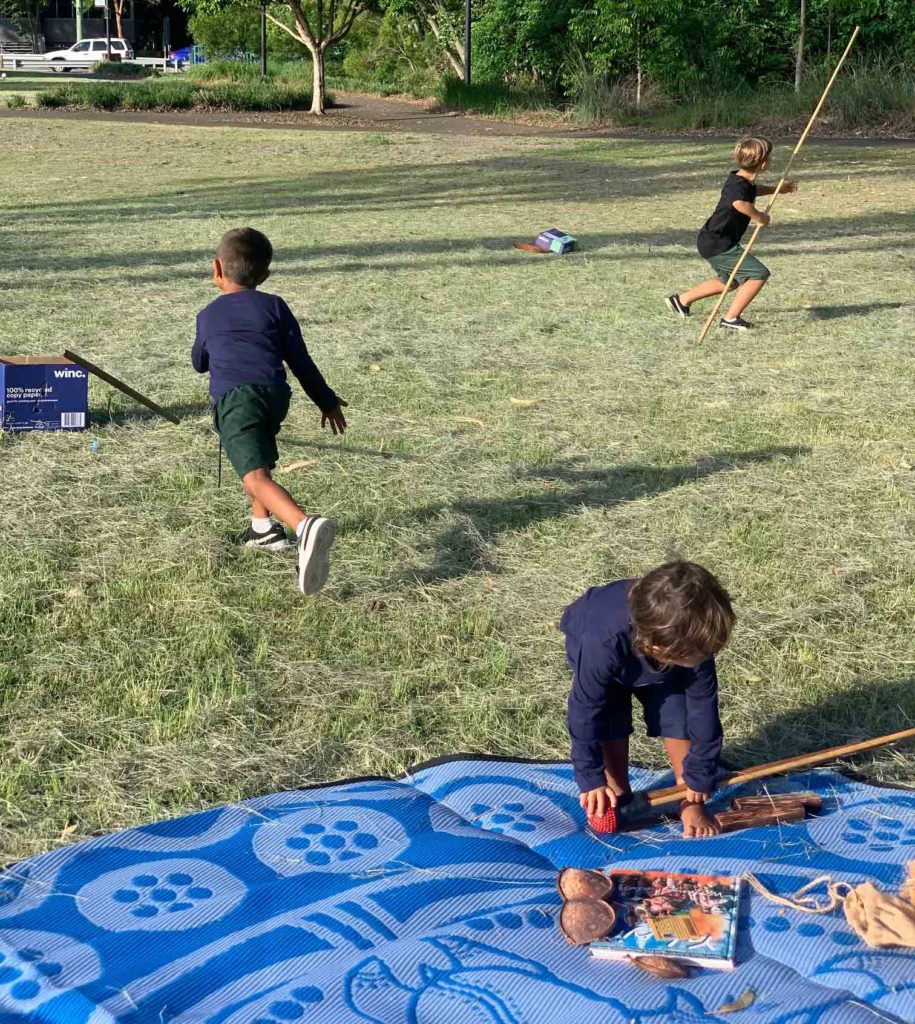Connecting First Nations children with Country and culture
Features
“Jarjums Connect Group was established for all children, carers, families, staff, First Nations Elders and Aboriginal and Torres Strait Islander community members to come together and immerse themselves in the sharing of First Nations history, cultural knowledge and a variety of cultural practices,” says Anglicare’s Lalania Tusa

Story Timeline
Reconciliation Action Plan achievements
- Pilgrimage to Wontulp-Bi-Buya (WBB) College
- St Mark’s supporting First Nations constitutional reform
- New Anglicare SQ cards further Reconciliation journey
- PATSIMAC group creating welcome and honouring the culture of the Yugambeh people
- Anglicare’s Reconciling Histories project
- Reconciliation: relationships and respect
- Reconciliation Prayer Spaces
- SEQ Friends of Nungalinya College – building cultural bridges
- Exploring mission in a post-colonial Australian church
- First Nations ‘icons’ – a portal to Aboriginal and Torres Strait Islander Spiritualities
- Ancient Aboriginal practice meets Divine Christian call
- Stunning Aboriginal dot paintings to travel around our Diocese
The Anglicare Southern Queensland Jarjums Connect Group is designed to nurture individual self-expression and offer cultural support in a safe environment with a supportive Cultural Support Worker for children and young people living in out-of-home care.
In January 2020, Jarjums Connect Group was established for all children, carers, families, staff, First Nations Elders and Aboriginal and Torres Strait Islander community members to come together and immerse themselves in the sharing of First Nations history, cultural knowledge and a variety of cultural practices.

Anglicare Southern Queensland’s Cultural Support Worker Lalania Tusa engaged in a painting activity with Jarjums Connect Group children
Thus, the Jarjums Connect Group directly supports Reconciliation in accordance with the Anglican Church Southern Queensland RAP Action (p.6, p.11) to:
“Develop, maintain and strengthen mutually beneficial external relationships with Aboriginal and Torres Strait Islander peoples, communities and organisations to support positive outcomes.”
Jarjums Connect Group meets fortnightly and is hosted in the Nerang Anglicare Southern Queensland Office and surrounding areas.
The name ‘Jarjums’ is the local Yugambeh language word for ‘children’ and was included in the naming of the ‘Jarjums Connect Group’ by me with the intention of incorporating more of the local language in the traditional area, or ‘Country’, that the children are residing in whilst in care.
This program’s primary focus is on cultural connectedness so that children and young people begin to develop and feel a strong sense of identity and belonging within themselves and the wider Aboriginal and Torres Strait Islander communities. This, in turn, helps to raise awareness of the Recognise Campaign and other pathways to greater recognition and self-determination of Aboriginal and Torres Strait Islander peoples (Anglican Church Southern Queensland RAP Action, p.11).

“This program’s primary focus is on cultural connectedness so that children and young people begin to develop and feel a strong sense of identity and belonging within themselves and the wider Aboriginal and Torres Strait Islander communities” (Lalania Tusa)
This is achieved through various ways in the fortnightly Jarjums Connect Group sessions, including via art and textiles that explores the cultural significance and importance of traditional symbols, stories, colours, totems and cultural art practices in Aboriginal and Torres Strait Islander cultures. The various art activities are stylised to cater for the varying ages that attend the Jarjums Connect Group and encourages the children to learn about what our First Nations were like in the past and how this contributes to contemporary Australian identity and their individual identities today. The art activities include boomerang and gumnut painting with Aboriginal symbols, ochre face painting with Yugambeh animals, clay moulding, How the echidna got their spikes story book dreaming drawing, sand art bottles, gratitude rock painting with acrylics and symbolised rock formation art.
Advertisement
Through hands-on fishing at the Nerang River, the children can participate in culturally significant hunting practices with the opportunity to share in the catch! Hunting is an important part of Aboriginal and Torres Strait Islander cultures and the children learn about the various forms of hunting through discussions at the river. Through participation, the children will take part in keeping First Nations cultures alive and learn about the cultural purpose behind hunting animals for survival. This component of the program is designed to develop a greater understanding and appreciation of Aboriginal and Torres Strait Islander hunting practices.
The Jarjums Connect Group is inclusive in accepting diverse cultures in learning about traditional song/dance rituals. The group explores the cultural significance of the songs/dances and why they are practised and taught orally. This aims to strengthen cultural knowledge within the children and carers in relation to the dance styles and what is worn in ceremonial dance. This gives the children and families the opportunity to be involved in learning a new song of both Aboriginal and Torres Strait Islander cultures.
Advertisement
Jarjums Connect Group also explores the cultural significance of natural seeds, bush tucker, grasses and flora/fauna. This enables the group to gain a better understanding and raise their awareness of the value of traditional gathering and the practices performed by the women of the tribe.
Through the yarning circle group discussions about bush tucker and natural seeded jewellery-making, the young people develop their confidence in creative arts and their understanding of traditional seed pods, bush tucker and natural fibres.
The sessions also encourage cultural competence through the exploration of Aboriginal and Torres Strait Islander plants, including their medicinal uses within the local area and wider Australian landscape.
We also offer informative culturally-based discussions around the history of how damper was prepared and made traditionally before the introduction of rations – particularly the introduction of white flour to the traditional diet and the effects of this on First Nations peoples. Through the session, the children and families learn and uncover the true history and uses of traditional Aboriginal and Torres Strait Islander artefacts, exploring the uses of various types of artefacts used across different ‘Country’, trading, and cultural protocols and practices in relation to who can use them. The artefacts that are presented and explored include the didgeridoo; clapsticks; Torres Strait Islander Kulups, wop, head dress, dugong bones and oil; turtle shell; boomerangs; woomera and spears; digging sticks; shields and stone axes; firesticks and rainmaker sticks and coolamon.

“The artefacts that are presented and explored include the didgeridoo; clapsticks; Torres Strait Islander Kulups, wop, head dress, dugong bones and oil; turtle shell; boomerangs; woomera and spears; digging sticks; shields and stone axes; firesticks and rainmaker sticks and coolamon” (Lalania Tusa)
Editor’s note: The new ACSQ Reconciliation Action Plan will be released in 2021.





